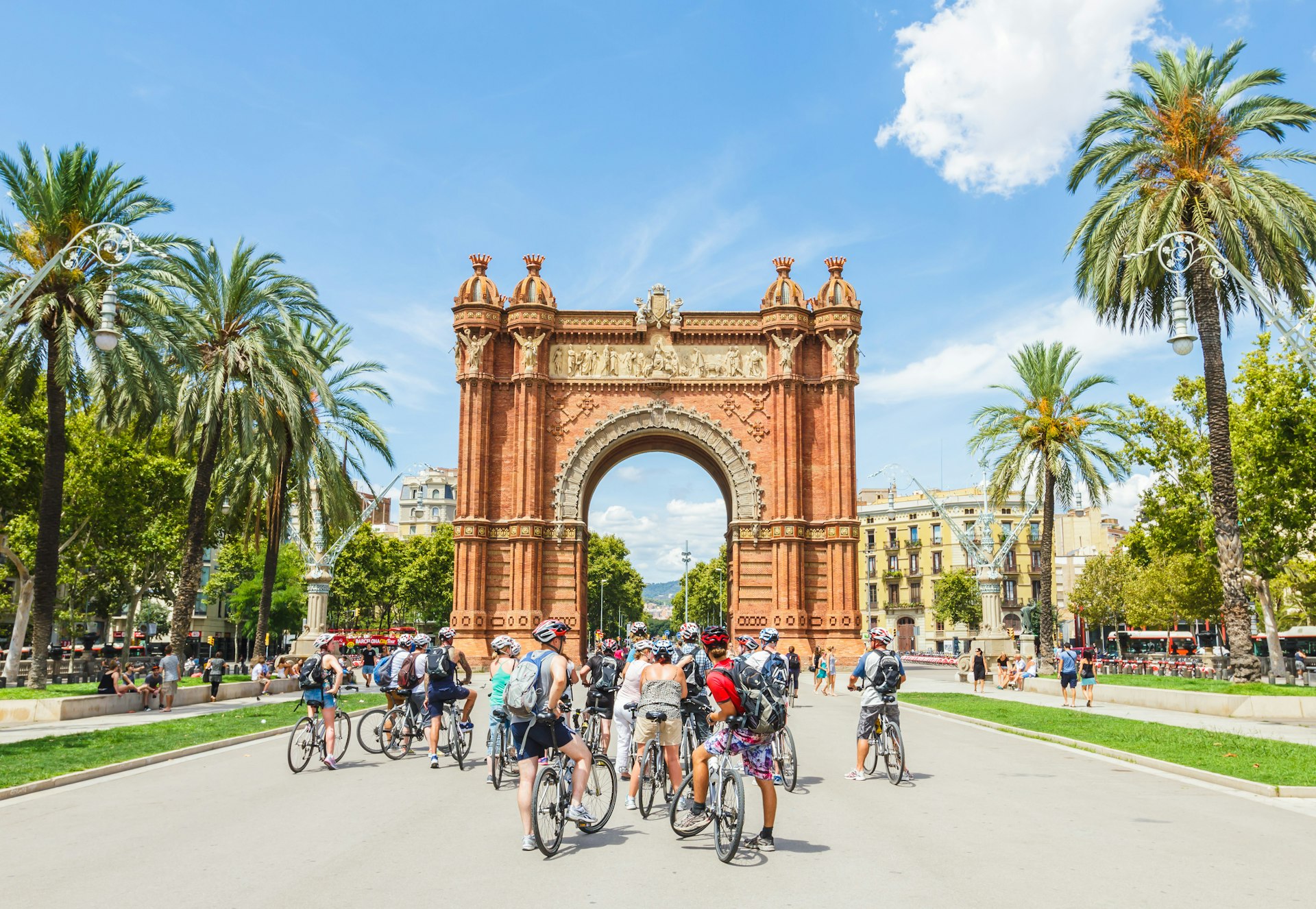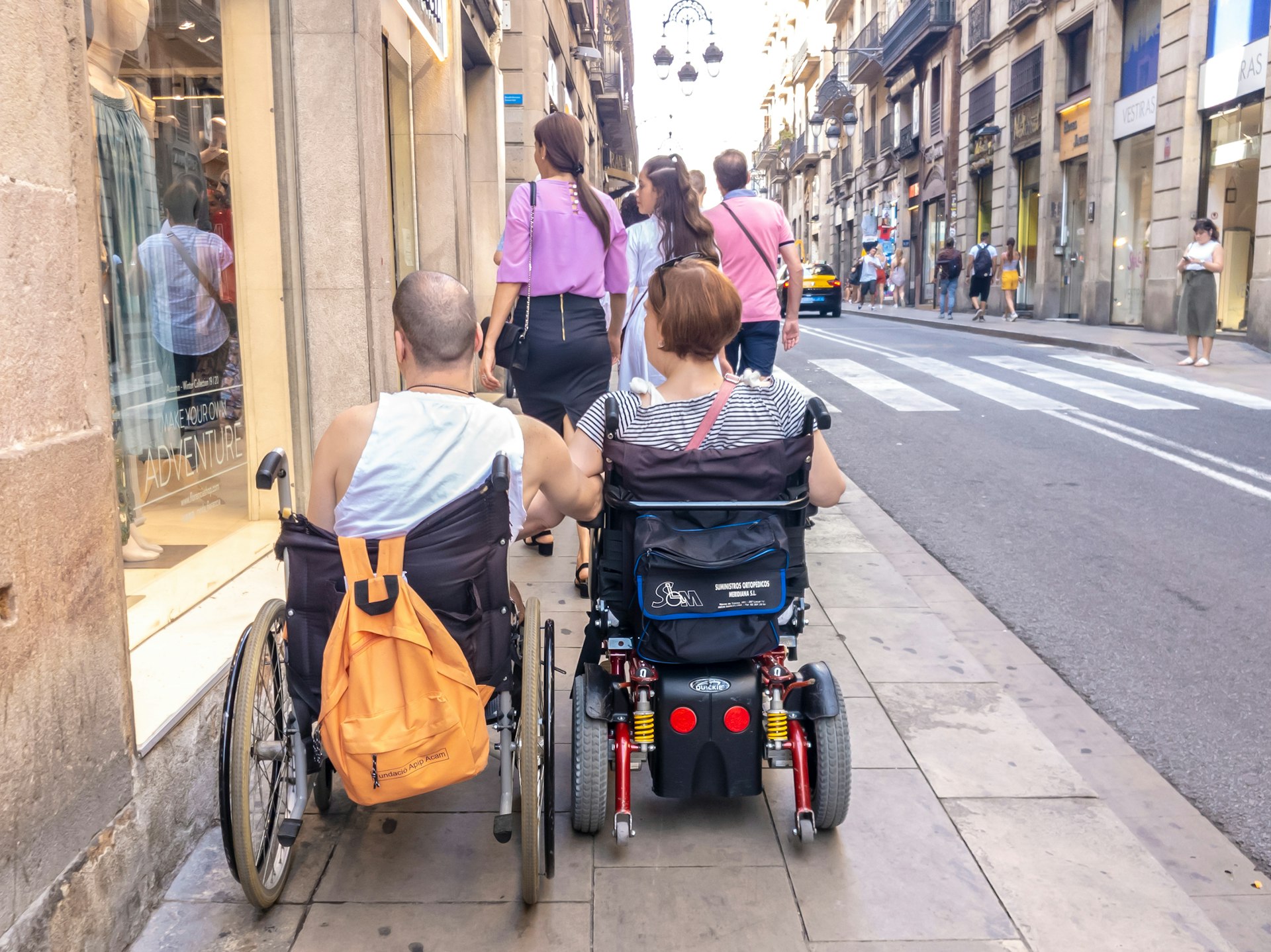
Barcelona is a perfectly sized city.
It is sufficiently big, so you always have something to do and something new to discover, and thanks to its relatively compact size and extensive metro and bus networks, you can easily get anywhere in the city in no time.
If you love exploring by bike, you’ll also be happy to hear the entire city was recently filled with 200km (124 miles) of bicycle lanes, making it one of the most manageable “big” cities to visit in Europe. Plenty of Barcelona’s attractions are in the Old City and easily reached by foot.
Here are the best ways to get around Barcelona.
Get local insight on destinations all over the world with our weekly newsletter delivered to your inbox.  The Barcelona Metro is quick and convenient © Jordi Salas / Getty Images
The Barcelona Metro is quick and convenient © Jordi Salas / Getty Images
Barcelona’s Metro is the best way to see the main sights
Composed of eight lines and 161 stations and operating since 1863, the Barcelona Metro is an extensive electric railway network that runs mostly underground, connecting downtown with the suburbs and several adjacent cities, including L’Hospitalet and Badalona.
Nowadays, Barcelona’s best neighborhoods and most of the city’s top things to do are well connected by metro. The Sagrada Família, Casa Batlló, Platja de la Barceloneta, Arc de Triomf and other spots are accessible from the metro, making it the most convenient way to get around Barcelona.
The metro runs from 5am until midnight Sunday to Thursday. On Friday, Saturday and the nights before public holidays, it operates until 2am.
Ride the Ferrocarrils de la Generalitat to the foothills of Barcelona
The Collserola mountain range limits the north of Barcelona. To access the districts at the foot of those hills and beyond, you must take the Ferrocarrils de la Generalitat (FGC).
The upper-class districts of Sant Gervasi, La Bonanova, Sarrià and Vallvidrera each have an FGC station. These districts are worth visiting, especially Sant Gervasi, where you find some of the best fine-dining restaurants in town.
Technically, the FGC belongs to the Barcelona Metro network, but there are some big differences. For example, instead of a metro tube, the FGC are actual trains. Moreover, they all depart from downtown, and the ticket price will differ depending on how far you go, while the regular metro has one price.
Want some help? Let Elsewhere plan your next trip.
The bus is the best late-night transport
With more than 200 lines and their own bus lanes, the hybrid city buses of Barcelona can be faster than the Metro, especially if the Metro line doesn’t have a direct connection with a certain attraction. Several bus lines run all night, making it easier to explore Barcelona after dark.
Learning the different routes can prove challenging, but Google Maps is a great travel aid, plus all stations have maps and detailed routes from their specific area. Tickets can be purchased only inside metro stations.
In a nod to its role in a carbon-zero future, Barcelona’s public transport system is also slowly changing to more energy-efficient vehicles, with all new buses being electric or hydrogen-powered.
 Ride the cable car above Barcelona’s port © arkanto / Shutterstock
Ride the cable car above Barcelona’s port © arkanto / Shutterstock
Get epic views from Barcelona’s cable cars and funiculars
Barcelona has funicular lines and cable cars that go to popular tourist attractions like Tibidabo, the tallest hill in the city and home to the church with the most incredible views. You can sail high over the port or access Montjuïc, another hill located on the west side of town, where you find the city’s castle.
Tickets can be bought in metro and FGC stations
All modes of public transportation in Barcelona work with the same travel card, which can be purchased in every metro and FGC station. Note that all prices mentioned refer to Zone 1, but the FGC goes to up to 6 zones, so different fares apply. A fare reduction was introduced in September 2022 for some of the most common tickets types and is expected to continue through the first half of 2023.
A single metro ride costs €2.40 (€5.15 if going to or coming from the airport), but if you plan to use transport lots want to get around Barcelona cheaper, visitors can choose from several integrated tickets:
- T-Dia (€10.50): Individual ticket valid for 24 hours. Good for solo travelers who are planning to take several metro rides in one day.
- T-Casual (€7.95): Individual ticket worth 10 journeys. Good for any solo travelers who stay in Barcelona for a few days.
- T-Familiar (€10): Multi-person travel card worth eight journeys. Ideal for families or groups of friends.
- T-Usual (€20): Individual travel card with unlimited journeys, valid for 30 days. Works best for solo travelers who are staying in the city for a longer period of time.
All integrated tickets have the advantage that one ride will still be valid when changing the mode of transport within a 75-minute window. However, if traveling with a single ticket, you will have to buy an additional one when switching from metro to bus or metro to FGC.
 See Barcelona on two wheels by cycling around the city © Littleaom / Shutterstock
See Barcelona on two wheels by cycling around the city © Littleaom / Shutterstock
Barcelona is becoming a bike-friendly city
Cycling is a great way to get around Barcelona. Less than a decade ago, you would barely see any cyclists in Barcelona, but in the last few years, the city has put a tremendous effort into making itself cycle-friendly. There are plans to add even more cycling lanes within the next few years.
Unfortunately, only residents can use the public rental service, Bicing (pronounced “be-zing”) and it is not available for tourists. However, visitors who wish to get around Barcelona by bike can easily get one at any of the bicycle rental shops all over the city. The city center is relatively flat, making it fairly easy to cycle around and explore.
Many sights in the Old City are easily explored on foot
Strolling down the streets of Barcelona – hopping from neighborhood to neighborhood while getting a sense of all the architecture and social contrasts – is one of the best things you can do in the city.
If you are staying in the Old City or anywhere downtown, most tourist attractions are within 2km to 3km (1 to 2 miles). La Barceloneta, El Raval, the Gothic Quarter, Passeig de Gràcia and Passeig del Born are all within walking distance from the city center, where you will find places like Barcelona Cathedral, the Museum of Contemporary Art, La Pedrera and even Barcelona’s best beaches. All these attractions can keep you busy for at least a few days.
Take a taxi for ease and comfort
Visitors who like to travel with a higher level of comfort can wave at any of the yellow taxis driving around Barcelona all day. Typically, fares start at €2.10, but at night and on weekends, prices may increase. Alternatively, several taxi apps operate in Barcelona. Hailo and MyTaxi are the most popular choices.
 Barcelona’s public transport, particularly buses and the metro, has been made accessible for travelers using wheelchairs © Linguist / Shutterstock
Barcelona’s public transport, particularly buses and the metro, has been made accessible for travelers using wheelchairs © Linguist / Shutterstock
Accessible transportation is a priority in Barcelona
Barcelona has one of the more accessible public transportation networks in Europe, with 147 metro stations (out of 161) being completely accessible to wheelchair users and 100% of buses having an access ramp, wide doors and reserved seats. The ultimate goal is to have universal access to the metro network.
The city administration is also working on making both the metro and bus accessible to blind people by implementing a voice navigation system and a metro guide in braille at all information points.
For more tips, download Lonely Planet’s free Accessible Travel Online Resources.



